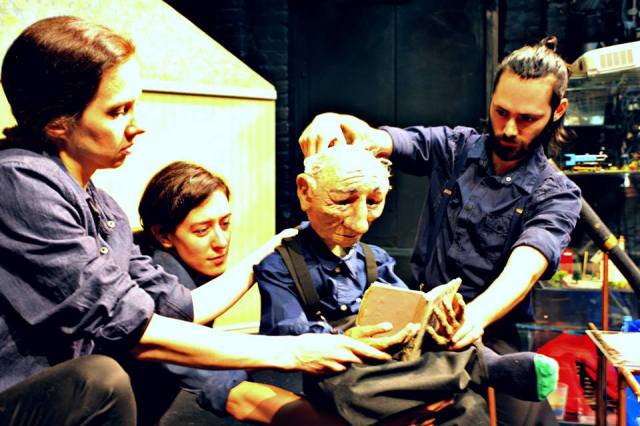Puppetry is powerful. It has the capacity to make people believe in life where there is none, to see a soul in a collection of strings and wooden sticks. And it doesn’t only affect the audience. It can have a profound effect on the puppeteer.
With this in mind, for my third time teaching at the English summer camp in Russia, this time through ENgage Theatre Arts, I focused on puppetry for the whole project. At last year’s camp I ran a puppetry workshop with the students where we made newspaper and string puppets then devised short scenes. With both age groups I worked with these workshops went down really well, so this year the final performances themselves involved puppets.

My wonderful colleagues at CLASS Study and Training Centre, with whom I work in Russia, had organised a theme for this year’s camp based on virtual reality and communities. We created a world within the camp – Campus – whose ruler, VerLock, delivered regular recorded messages to the students containing instructions, comments and clues to riddles. We realised that puppetry could work really well within this theme, so I asked my students to feature VerLock as a character in their final pieces, then looked forward to seeing their interpretations of this mysterious figure.

Teachers with their puppet versions created by the first group
This theme explored community-building through the separation of the students into different communities or nations. Carrying this on into my drama sessions, I tasked the students with asking lots of ‘What if?’ questions about their nations and Campus as a whole. All fictional stories are basically the writer asking ‘What if this happened? Or this? Or that?’ then providing a possible answer to this question through their story. Working in their separate nation communities the students explored various different scenarios until they had boiled it down to their favourite, which they then built their final performances on.
 They were all enthusiastic about the puppetry, even if a little daunted when I first told them they were going to create and perform puppet shows to their peers. Natural leaders emerged within the groups, and I worked with them to ensure that everyone in each community had a role, while trying to make sure the leaders weren’t relied on too heavily by everyone else. It became clear which parts of the process each student enjoyed and excelled at or found challenging. One boy struggled to engage with the devising process, but as soon as we started making the puppets he got stuck right in and his excitement and enthusiasm was wonderful! I could see him working through problems and coming up with different solutions as he tried this way of attaching the neck or that way of creating a shoulder joint.
They were all enthusiastic about the puppetry, even if a little daunted when I first told them they were going to create and perform puppet shows to their peers. Natural leaders emerged within the groups, and I worked with them to ensure that everyone in each community had a role, while trying to make sure the leaders weren’t relied on too heavily by everyone else. It became clear which parts of the process each student enjoyed and excelled at or found challenging. One boy struggled to engage with the devising process, but as soon as we started making the puppets he got stuck right in and his excitement and enthusiasm was wonderful! I could see him working through problems and coming up with different solutions as he tried this way of attaching the neck or that way of creating a shoulder joint.

The final performances were an absolute delight – a little rough round the edges, as to be expected, but utterly charming. What stood out for me was the teamwork involved in the process and the final piece, and the level of creativity the students showed. All four groups I worked with created their puppets in a slightly different way, and all four stories were different, though interestingly there were some moral themes that ran through all of the ideas.
I love what I do. Travelling to interesting places, experiencing different cultures, sharing my passion for theatre and puppetry, and working with students who are discovering their own creative potential is immensely rewarding. Like every performer or creative, what I don’t enjoy is constantly worrying about money, the job insecurity and the rejections. At the end of each creative project there’s the necessity to get a day job back in an office for a bit, returning to a life I thought I’d left far behind when I set off to drama school (oh how naïve!). But when I’m feeling glum and I start wondering whether this career change really was a good idea, and isn’t it about time I said: “Well that was a lot of fun and I’ve had a great time, but now I really should get back to something sensible”, I remember what one student said to me at the end of a puppet-making session on camp: “I love doing this. I wish we got to do things like this at school”. Heart strings suitably torn, I realised I have to keep going, to keep creating and making and sharing. The joy I witnessed as I saw that boy delighting in the chance to be creative – that alone is enough to keep me going.



































